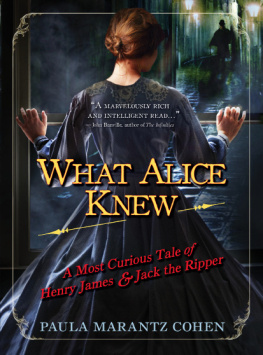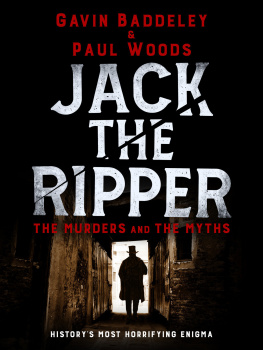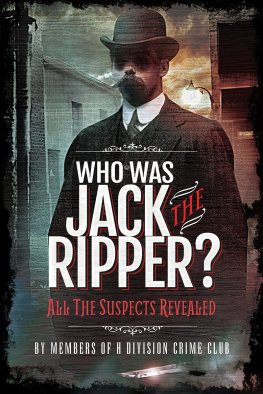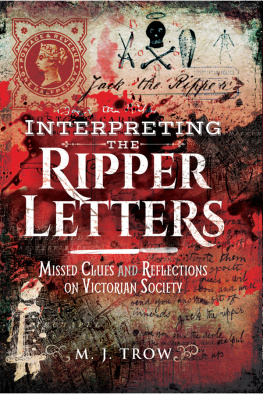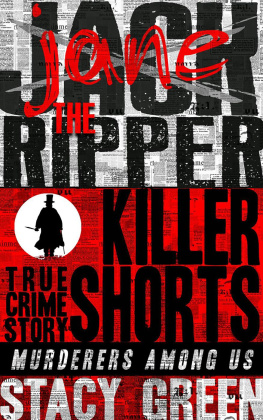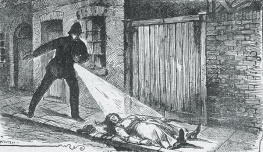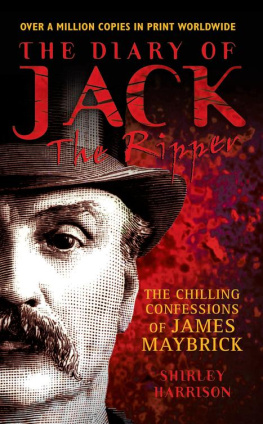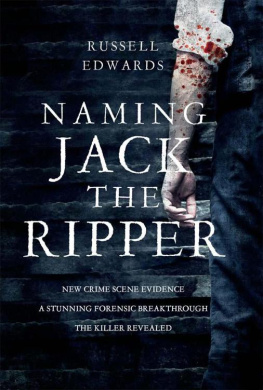Portrait Of A Killer Jack The Ripper Case Closed PATRICIA CORNWELL Copyright (c) 2002
To Scotland Yard's John Grieve You would have caught him.
CONTENTS CHAPTER One: MR. NOBODY CHAPTER Two: THE TOUR CHAPTER Three: THE UNFORTUNATES CHAPTER Four: BY SOME PERSON UNKNOWN CHAPTER Five: A GLORIOUS BOY CHAPTER Six: WALTER AND THE BOYS CHAPTER Seven: THE GENTLEMAN SLUMMER CHAPTER Eight: A BIT OF BROKEN LOOKING GLASS CHAPTER Nine: THE DARK LANTERN CHAPTER Ten: MEDICINE OF THE COURTS CHAPTER Eleven: SUMMER NIGHT CHAPTER Twelve: THE YOUNG AND BEAUTIFUL CHAPTER Thirteen: HUE AND CRY CHAPTER Fourteen: CROCHET WORK AND FLOWERS CHAPTER Fifteen: A PAINTED LETTER CHAPTER Sixteen: STYGIAN BLACKNESS CHAPTER Seventeen: THE STREETS UNTIL DAWN CHAPTER Eighteen: A SHINY BLACK BAG CHAPTER Nineteen: THESE CHARACTERS ABOUT CHAPTER Twenty: BEYOND IDENTITY CHAPTER Twenty-One: A GREAT JOKE CHAPTER Twenty-Two: BARREN FIELDS AND SLAG-HEAPS CHAPTER Twenty-Three: THE GUEST BOOK CHAPTER Twenty-Four: IN A HORSE-BIN CHAPTER Twenty-Five: THREE KEYS CHAPTER Twenty-Six: THE DAUGHTERS OF COBDEN CHAPTER Twenty-Seven: THE DARKEST NIGHT IN THE DAY CHAPTER Twenty-Eight: FURTHER FROM THE GRAVE
There was a general panic, a great many excitable people declaring that the evil one was revisiting the earth. - H.M., ANONYMOUS EAST END MISSIONARY, 1888
CHAPTER ONE
MR. NOBODY
Monday, August 6, 1888, was a bank holiday in London. The city was a carnival of wondrous things to do for as little as pennies if one could spare a few.
The bells of Windsor's Parish Church and St. George's Chapel rang throughout the day. Ships were dressed in flags, and royal salutes boomed from cannons to celebrate the Duke of Edinburgh's forty-fourth birthday.
The Crystal Palace offered a dazzling spectrum of special programs: organ recitals, military band concerts, a "monster display of fireworks," a grand fairy ballet, ventriloquists, and "world famous minstrel performances." Madame Tussaud's featured a special wax model of Frederick II lying in state and, of course, the ever-popular Chamber of Horrors. Other delicious horrors awaited those who could afford theater tickets and were in the mood for a morality play or just a good old-fashioned fright. Dr. Jekyll and Mr. Hyde was playing to sold-out houses. The famous American actor Richard Mansfield was brilliant as Jekyll and Hyde at Henry Irving's Lyceum, and the Opera Comique had its version, too, although poorly reviewed and in the midst of a scandal because the theater had adapted Robert Louis Stevenson's novel without permission.
On this bank holiday there were horse and cattle shows; special "cheap rates" on trains; and the bazaars in Covent Garden overflowing with Sheffield plates, gold, jewelry, used military uniforms. If one wanted to pretend to be a soldier on this relaxed but rowdy day, he could do so with little expense and no questions asked. Or one could impersonate a copper by renting an authentic Metropolitan Police uniform from Angel's Theatrical Costumes in Camden Town, scarcely a two-mile stroll from where the handsome Walter Richard Sickert lived.
Twenty-eight-year-old Sickert had given up his obscure acting career for the higher calling of art. He was a painter, an etcher, a student of James McNeill Whistler, and a disciple of Edgar Degas. Young Sickert was himself a work of art: slender, with a strong upper body from swimming, a perfectly angled nose and jaw, thick wavy blond hair, and blue eyes that were as inscrutable and penetrating as his secret thoughts and piercing mind. One might almost have called him pretty, except for his mouth, which could narrow into a hard, cruel line. His precise height is unknown, but a friend of his described him as a little above average. Photographs and several items of clothing donated to the Tate Gallery Archive in the 1980s suggest he was probably five foot eight or nine.
Sickert was fluent in German, English, French, and Italian. He knew Latin well enough to teach it to friends, and he was well acquainted with Danish and Greek and possibly knew a smattering of Spanish and Portuguese. He was said to read the classics in their original languages, but he didn't always finish a book once he started it. It wasn't uncommon to find dozens of novels strewn about, opened to the last page that had snagged his interest. Mostly, Sickert was addicted to newspapers, tabloids, and journals.
Until his death in 1942, his studios and studies looked like a recycling center for just about every bit of newsprint to roll off the European presses. One might ask how any hard-working person could find time to go through four, five, six, ten newspapers a day, but Sickert had a method. He didn't bother with what didn't interest him, whether it was politics, economics, world affairs, wars, or people. Nothing mattered to Sickert unless it somehow affected Sickert.
He usually preferred to read about the latest entertainment to come to town, to scrutinize art critiques, to turn quickly to any story about crime, and to search for his own name if there was any reason it might be in print on a given day. He was fond of letters to the editor, especially ones he wrote and signed with a pseudonym. Sickert relished knowing what other people were doing, especially in the privacy of their own not-always-so-tidy Victorian lives. "Write, write, write!" he would beg his friends. "Tell me in detail all sorts of things, things that have amused you and how and when and where, and all sorts of gossip about every one."
Sickert despised the upper class, but he was a star stalker. He somehow managed to hobnob with the major celebrities of the day: Henry Irving and Ellen Terry, Aubrey Beardsley, Henry James, Max Beerbohm, Oscar Wilde, Monet, Renoir, Pissarro, Rodin, Andre Gide, Edouard Du-jardin, Proust, Members of Parliament. But he did not necessarily know many of them, and no one - famous or otherwise - ever really knew him. Not even his first wife, Ellen, who would turn forty in less than two weeks. Sickert may not have given much thought to his wife's birthday on this bank holiday, but it was extremely unlikely he had forgotten it.
He was much admired for his amazing memory. Throughout his life he would amuse dinner guests by performing long passages of musicals and plays, dressed for the parts, his recitations flawless. Sickert would not have forgotten that Ellen's birthday was August 18th and a very easy occasion to ruin. Maybe he would "forget." Maybe he would vanish into one of his secret rented hovels that he called studios. Maybe he would take Ellen to a romantic cafe in Soho and leave her alone at the table while he dashed off to a music hall and then stayed out the rest of the night. Ellen loved Sickert all her sad life, despite his cold heart, his pathological lying, his self-centeredness, and his, habit of disappearing for days - even weeks - without warning or explanation.
Walter Sickert was an actor by nature more than by virtue of employment. He lived on the center stage of his secret, fantasy-driven life and was just as comfortable moving about unnoticed in the deep shadows of isolated streets as he was in the midst of throbbing crowds. He had a great range of voice and was a master of greasepaint and wardrobe. So gifted at disguise was he that as a boy he often went about unrecognized by his neighbors and family.
Throughout his long and celebrated life, he was notorious for constantly changing his appearance with a variety of beards and mustaches, for his bizarre dress that in some cases constituted costumes, for his hairstyles - including shaving his head. He was, wrote French artist and friend Jacques-Emile Blanche, a "Proteus." Sickert's "genius for camouflage in dress, in the fashion of wearing his hair, and in his manner of speaking rival Fregoli's," Blanche recalled. In a portrait Wilson Steer painted of Sickert in 1890, Sickert sports a phony-looking mustache that resembles a squirrel's tail pasted above his mouth.
Next page

